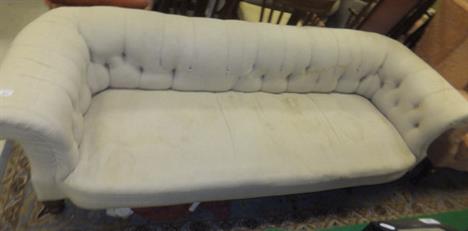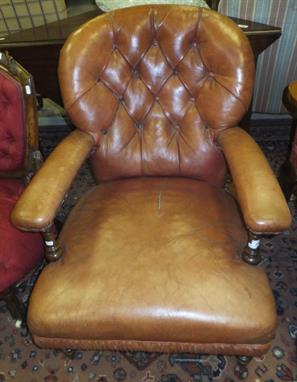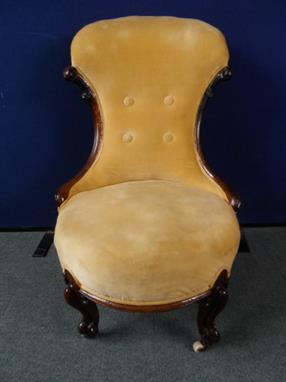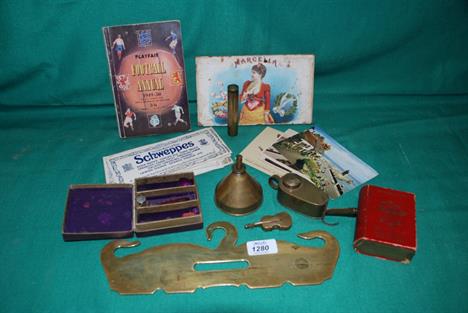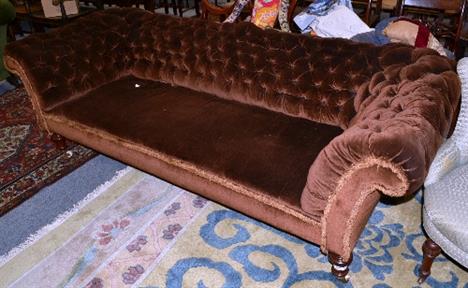We found 110990 price guide item(s) matching your search
There are 110990 lots that match your search criteria. Subscribe now to get instant access to the full price guide service.
Click here to subscribe- List
- Grid
-
110990 item(s)/page
A Pair of Georgian Style Mahogany Upholstered Armchairs, 20th Century. Dimensions: h: 36 x w: 25 1/2 x d: 28 in. Other Notes: *** Please inquire for shipping estimate prior to bidding. Shipping costs may exceed item values. *** Note condition: button missing. Any condition statement is given as a courtesy to a client, is only an opinion, and should not be treated as a statement of fact. Gray`s Auctioneers LLC shall have no responsibility for any error or omission. The absence of a condition statement does not imply that the lot is in perfect condition or completely free from wear and tear, imperfections or the effects of aging. Starting Price: $60
**AN INDIAN SWORD (FIRANGI), LATE 17TH/18TH CENTURY with broad blade swelling towards the tip, double-edged for its last portion and later etched in imitation of watering, steel hilt extending over the forte and with a pair of additional pierced shaped panels, broad figure-of-eight shaped guard extending up to form the knuckle-guard, characteristic pommel with pronounced attenuated button, retaining traces of silver plating, and leather-covered grip 73cm; 28 3/4in blade
**AN INDIAN TALWAR, 19TH CENTURY with curved blade double-edged towards the point, later etched in imitation of watered pattern on each face, steel hilt of characteristic form including quillons with flat button-shaped terminals and large disc pommel, retaining traces of gold koftgari decoration over its surface, and integral grip decorated en suite 84.5cm; 33 1/4in blade
A STILETTO, 17TH CENTURY in excavated condition and formed entirely of iron, with slender tapering blade, straight moulded cross-piece with button-shaped terminals, moulded grip, and button shaped pommel 22cm; 8 3/4in blade Provenance Excavated on the site of the Rose Theatre, Southwark, London In view of the find site and the flimsy nature of the steel it has been suggested that this may have been for theatrical use.
AN ENGLISH OR FLEMISH CLOSE HELMET, CIRCA 1550 with one-piece skull rising to a low boldly roped medial comb pierced at its apex with two large holes, the foremost at one time retaining a later funerary crest, and visor, upper bevor and bevor attached to it by common pivots (the shank of the right replaced and threaded to receive a nut), the visor with stepped centrally divided vision fitted at its right side with a lifting-peg (replaced) that also serves as a pull to release the spring-catch securing it to the upper bevor, the latter of prow-shaped form pieced in a raised rib across the mouth with nine circular ventilation-holes and at its right side with five smaller ventilation-holes in dice-formation, the upper bevor and bevor each secured at their right sides by spring-catches with push-button releases (the button of the catch for the bevor replaced and the hole to receive its catch reinforced with a patch), and two gorget-plates front and rear (the lowest in each case restored), the main edges of the helmet formed with roped inward turns accompanied by recessed borders, and the skull decorated to either side of its comb with a pair of similar recessed bands of which the outer ones diverge just above the nape (pitted and worn overall) 28 cm; 11 in Provenance Athelhampton Hall, Dorset (probably originally from Puddletown Church, Dorset) Christie`s 8 December 1946, lot 146 The helmet owes its survival to having been suspended over an English tomb as part of an heraldic funerary achievement. Similar helmets can be seem in the churches of Whaddon, Buckinghamshire, Netherbury, Dorsetshire, Pembury, Kent, and Lydiard Tregoze, Wiltshire (Francis Henry Cripps-Day, `On Armour Preserved in English Churches, in Guy Francis Laking, European Armour and Arms, Vol. V, 1922, pp. 164-5, 174, 199-200,263 & 266, figs 1597, 1608, 1661 & 1792).
A STONEBOW BY WALKER, NORWICH, CIRCA 1820 with slender steel bow fitted with an early string of twisted cord with wooden spacers, figured walnut tiller with chequered grip (small cracks and bruising), fitted with a pair of shaped steels, moulded steel finial, sprung folding fore-sight, steel gaffle fitted with signed engraved folding back-sight and button trigger, butt-cap and escutcheon engraved with the owner`s initials `WG` (the steel parts patinated) the first: 76.5cm; 30 1/8in tiller Isaac Walker is recorded in Norwich, circa 1797-1839.
A FINE AND RARE 80 BORE THURINGIAN WHEEL-LOCK SPORTING RIFLE, CIRCA 1590 with very heavy swamped sighted barrel, small bore, probably for birding, rifled with eight slender grooves, flat lock struck with the maker`s initials `V.S.` , retained by two side nails, fitted with external wheel with low domed brass cover engraved with scrollwork and retained by an engraved moulded brass band decorated with trellis pattern interrupted by fruit and foliage, finely engraved pan-fence, engraved sliding pan-cover decorated by a grotesque and with button release, engraved dog formed as a scaly monster rising from a scroll of foliage, and a later grotesque rondel, the inside with filed spring and details retained by a shaped bridle delicately engraved with a grotesque mask, full stock profusely inlaid over its entire surface in staghorn with scrolling ball flower tendrils inhabited by exotic birds within ropework frames, a broad ropework panel along the entire length of the underside of the fore-end, a staghorn panel decorated with a bird-of-prey plucking fruit beneath the lock, the tang enclosed by staghorn panels decorated with bearded profiles within scrollwork frames, the butt applied with staghorn veneer engraved with strapwork involving masks, garlands of round fruit and podded legumes on the spine, with raised cheek-piece decorated en suite including a stag set upon by a hound on the left and with patchbox with sliding cover veneered in staghorn with a Wildman clutching an arrow and a flaming orb beneath further matching garlands of fruit on the right, later engraved staghorn butt-cap, steel trigger-guard shaped for the fingers, engraved staghorn ramrod-pipes and fore-end cap (the inlay with minor restorations and lifting, the butt with a small crack), and wooden ramrod with staghorn tip, perhaps the original 100cm; 39 3/8in barrel Provenance The Lord Astor of Hever, sold Sotheby`s, London, 5th May 1983, lot 75. A sporting rifle, formerly in the collection of Beriah Botfield at Norton Hall, signed by the same lockmaker and decorated in an identical manner is preserved in the Royal Armouries, Leeds (inv. no. XII.1197). The armouries rifle is of larger bore, shorter barrel length and is engraved with the arms of Saxony on the butt-cap. It is evident that these two guns were made for the same patron and probably formed part of a larger garniture. See G. Rimer 2001, p.42. This rifle belongs to a distinctive group of highly decorated wheel-lock firearms that have been attributed to the hand of Klaus Hirt of Wassungen, Thuringia on the basis of a single pistol that is signed by him and is preserved in the Historischen Museum, Bern. A pistol from this group signed by the stockmaker `L.B.` was sold Sotheby`s Olympia, 5th December 2002, lot 241. Another unsigned pistol decorated in this manner was sold in these rooms, 5th December 2012, lot 303.
Allcock Aerial alloy trotting reel 3.25in wide, retaining much of the original finish, the face plate with 6 spokes, centre pin, two ivorine handles and 8 perforation holes, the backplate with ratchet button and circular stamped makers name `The Allcock Aerial S.Allcock and Co. Ltd. Redditch England` the interior numbered 39, with smooth brass foot.
A George III Scottish silver teapot and stand, Robert Gray, Glasgow, circa 1776-84, of shaped oval form with angular wood scroll handle and flush-fitting cover with button finial, bright-cut engraved borders throughout, crested, with conforming stand on four cast claw and ball feet, 12.5cm high, 21.5oz 17dwt all in Engraving tired. The cover repaired and slightly bowed. Repairs to the base and sides of the pot. Brightly cleaned, clear marks. The feet on the stand with repairs. 280113 21.5oz
A George III silver teapot and stand, Benjamin Montague, London 1789, of oval form with wood scroll handle and domed cover with oval button finial, bright cut engraved borders and twin circular cartouches engraved with initials and crest beneath a motto, the stand conforming on four bracket feet, the teapot 14.5cm high, 14oz 8dwt all in The hinge of the cover and the domed cover with repairs. The handle a later replacement. 280113 14oz
-
110990 item(s)/page





